My kid missed the first week of first grade for lessons he’d never learn in school
Editor’s Note: Monthly Ticket is a CNN Travel series that spotlights some of the most fascinating topics in the travel world. In August, we’re making the most of the last month of summer by highlighting some of the top ways to enjoy the season.
My son’s eyes pooled like a melting glacier. We were in Churchill, a town of roughly 900 people nicknamed the “Polar Bear Capital of the World,” in Canada’s Manitoba province.
It was mid-August, and I’d pulled Nico out of his first week of first grade in Florida for a “Family Learning Adventure” with Frontiers North Adventures and a trip I was sure would be worth missing a week of school to attend.
But I’d been wondering whether anything was sinking in. Together with several other kids in our group aged five to 10, my restless boy was suddenly rapt with attention in the town’s Polar Bears International office. He was listening to a story about a bear named Ursula who had been tracked for several seasons around Churchill and finally far out on the sea ice in the middle of Hudson Bay with her two cubs before her tracking signal went offline.
The device was eventually found washed ashore on land. Ursula made it back, but the fate of her cubs was unknown.
Nico, 6, had just seen his first polar bear in the wild, a thin male splayed across rocks in the Churchill Wildlife Management Area, just outside of town, where our Tundra Buggy driver, Jim Baldwin, had spotted the bear from a couple football fields away. As we approached in the towering vehicle with tires up to my shoulders, Baldwin told us the bear was too skinny for his liking.
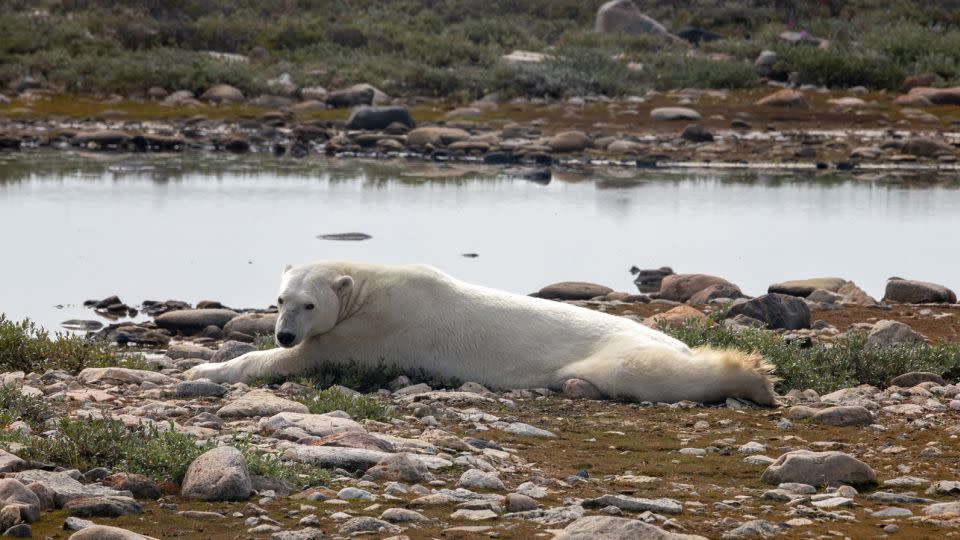
By mid-August, Churchill’s polar bears had been off the Hudson Bay sea ice for 60 days, essentially fasting until it would freeze over in late October or November. Then they could hunt for seals again.
We learned the window of ice-free time in Hudson Bay was getting longer, with the ice melting earlier in the year and freezing later each year. Hudson Bay polar bears are among the most vulnerable on Earth because of loss of sea ice, with their numbers in sharp decline.
We didn’t have all the facts about what happened to Ursula and her cubs, but I could see my son was putting two and two together. “Did they … die?” He turned to me and whispered, tears spilling over.
I told him we didn’t know.
Unexcused absences and a different kind of classroom
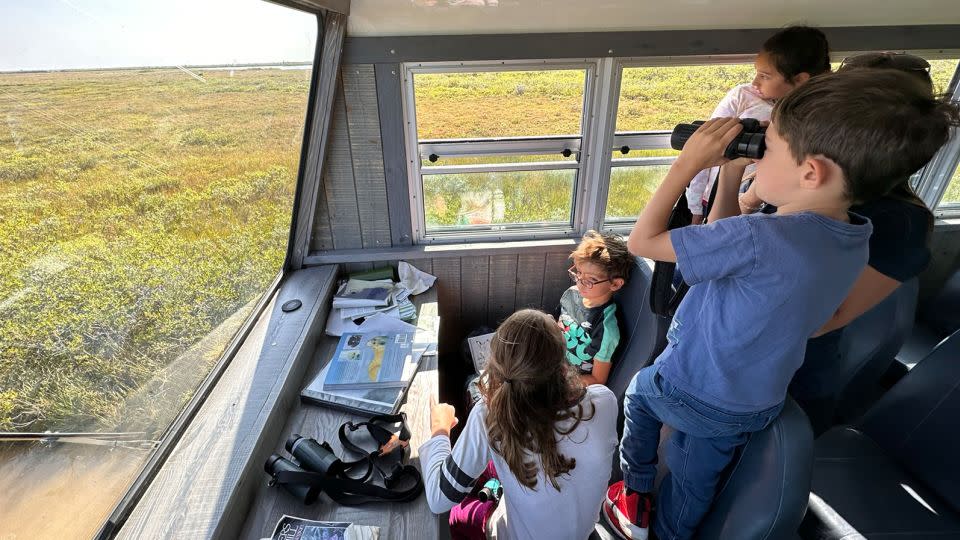
Back home in Florida, the stories we share usually have a happy ending, all the better for a good night’s sleep. But as a firm believer that travel is the best education, I’d called in a week of “unexcused absences” to Nico’s public elementary school in Tampa and came to this remote place with no road access.
Most visitors arrive in Churchill via a two-day train journey from Winnipeg, Manitoba’s capital, more than 600 miles (965 kilometers) south, or by commercial flights on Calm Air, which can cost around $2,000CAD (about $1475 USD) roundtrip for the 2.5-hour flight from Winnipeg.
Once you’re on the ground, things are similarly pricey. A comfortable but no-frills room at the Tundra Inn in town is $335 CAD ($247.26) per night during fall’s peak polar bear season. Summertime beluga-watching tours by Zodiac cost $125 CAD ($92.26 USD pp). And groceries cost a pretty penny, too.
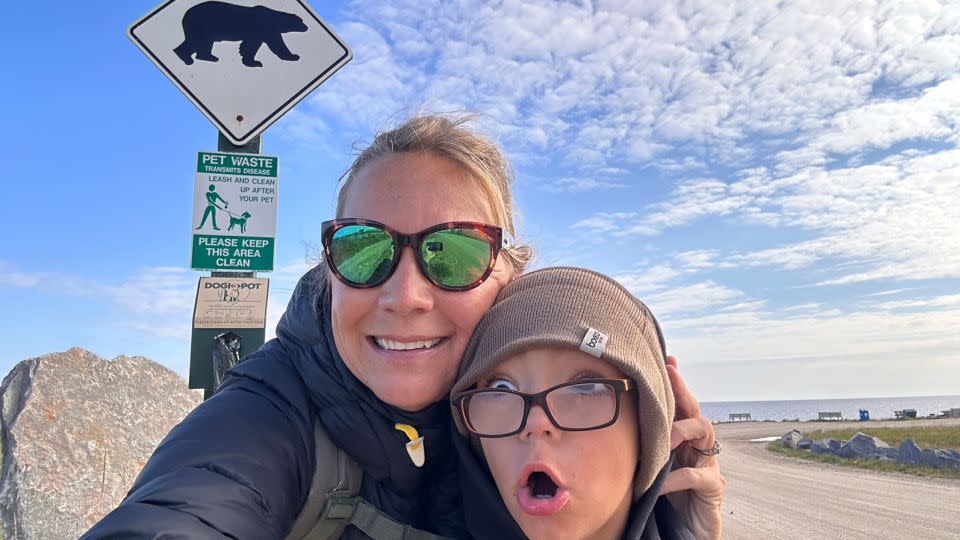
I’d ventured this far with my son in hopes of painting a real picture for him from the Arctic animal books we’d paged through and talks we’d had about the climate crisis. This was a place that was changing forever in our lifetimes, the time to see it was now.
The last time I’d been among polar bears was just before I got pregnant with Nico, on a sailing adventure in Svalbard, an Arctic island off Norway. Together with friends on a small boat named Barba, I witnessed open coastline where sea ice should have been, saw a polar bear scavenging for bird eggs because the seals were out of reach and even used a wooden pole to fend off a hungry bear that tried to board our boat, perhaps smelling the cod we’d left out to dry.
I wasn’t looking to get that up close and personal with the animals with my son. But considering the impact traveling in the Arctic had on me in my early 40s and knowing how quickly the region was changing, I was eager to give Nico a head start on lessons you can’t get in school.
Our Frontiers North Adventures guide, Jennifer Diment, briefed us on our trip, telling us we’d witness the largest migration of beluga whales in the world. It happens every July and August in the Churchill River and nearby estuaries, when the cetaceans arrive to feed, mate and calve in the sheltered waters.
We’d learn about the region’s Indigenous peoples and the perils a warming Arctic brings to their way of life. And we’d likely see polar bears, she said, with unusually high numbers of them spotted around Churchill, their natural migration corridor, this summer.
Nico pushed his toy car across the airport’s floor as she talked.
“Churchill is the most representative place for kids to get a clear picture of what is happening with our environment and climate change,” Diment, a biologist, reassured me.
“When you see the number of days the polar bear population here has gone without eating because of the number of days the area has been free of sea ice, then you see a polar bear on land, it really puts things in context.”
Into the realm of the polar bear
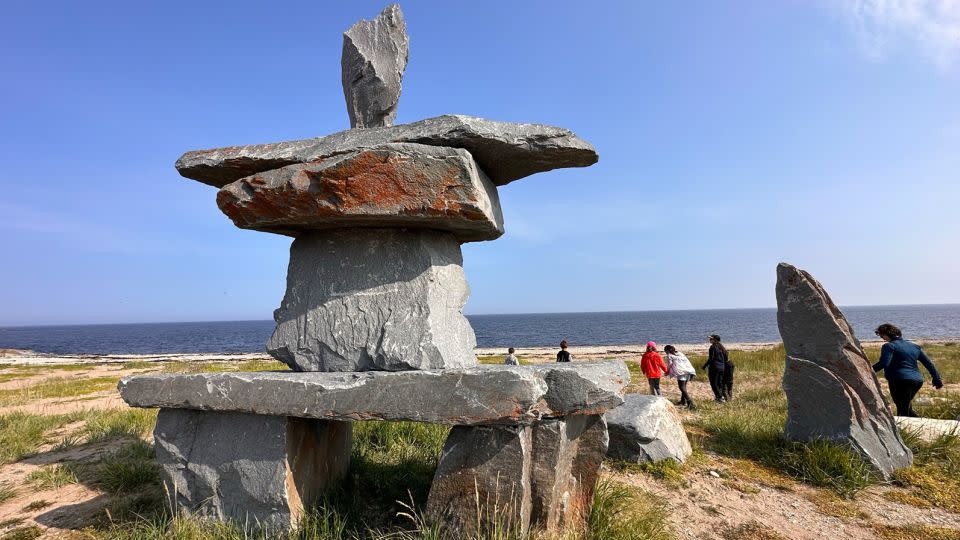
Context in Churchill, which sits at roughly the same latitude as Scandinavian cities such as Stockholm and Oslo and is the southernmost place in the world to see wild polar bears, comes in being immersed in a surprisingly accessible slice of true wilderness.
Helicopters patrol the town’s perimeter to keep children safe while trick or treating on Halloween night (when nobody would dare dress like a bear). And a large sign with the Polar Bear Alert Line’s phone number and a warning to never go outside after 10 p.m. is the first thing you see upon landing at the airport.
Together with our group of four other families – hailing from Toronto, Denver, Vancouver and Washington, DC (including two kids who were similarly missing their first week of school) – we set out to learn all we could.
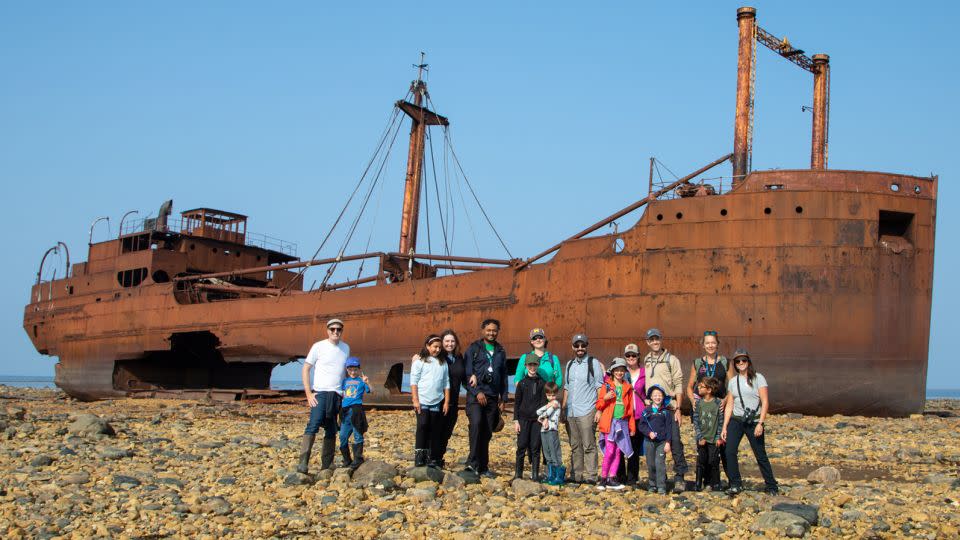
During a low-tide walk to the SS Ithaca, a rusting freighter grounded along the shore of Hudson Bay since 1960, the kids marveled at fossils and the idea that they were strolling across the seabed while my son splashed in tidal pools and gaped at his first real shipwreck (“Is it bigger than the Titanic?”). We all got a jolt of adrenaline when our polar bear guard – essential in these parts and armed with a rifle that could shoot cracker shells as well as more serious ammunition as a last resort – spotted a mother and two cubs strolling a distant shoreline.
We stopped to see the town’s Polar Bear Holding Facility (often referred to as the “polar bear jail”), a hangar where repeat-offender bears that have refused to leave town by other means are held for 30 days without food as a deterrent to coming back before being released into remote areas away from town. Conservation officer Chantal Maclean shared her unusual career with the kids.
“It’s not something I ever heard about at a job fair growing up,” she said, explaining how the bears are trapped, darted and later transported by truck or helicopter as part of the town’s Polar Bear Alert Program to keep both them and the area’s humans safe.
“This year, the bears have been forced onto land a lot earlier because they got off the sea ice a lot earlier,” Maclean told the kids. “They’re here in really high numbers because the ice melted earlier.”
Nico wanted to know who was in jail for what, and the kids all giggled to learn a large male polar bear was among the three prisoners after he was caught gorging on bags of dog food at the port.
“Last year, we had 18 calls about bears around town at this time,” Maclean told us. “This year we’ve already had around 80.”
Clearly impressed with her, Nico turned to me and said, “I wish you could still be my mommy but also be Chantal.” I was thrilled he’d gained a new option for answering what he wants to be when he grows up.
Belugas, belugas everywhere
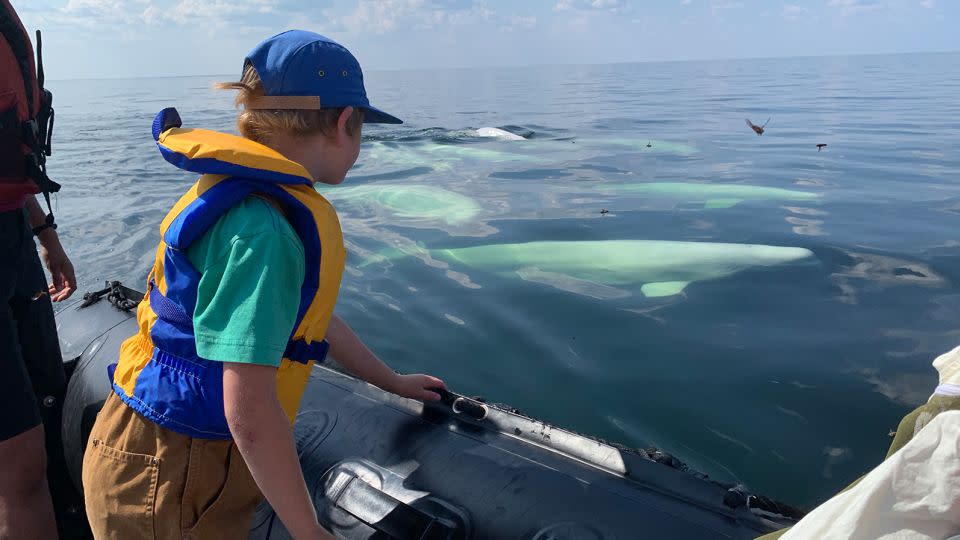
Everywhere you go near the water in Churchill during July and August, the rounded backs of beluga whales surface like white caps. They arrive as soon as the sea ice breaks up to feast on small fish called capelin that spawn here.
One afternoon, Nico and I boarded a Zodiac while others in our group kayaked out for a closer look at the belugas. They paraded alongside our vessels, peering up from underwater and frolicking in the boat’s wake, protected from the propeller by a cage around it. Just-born babies appeared velcroed to their sides (and yes, everyone broke out singing Raffi’s “Baby Beluga”).
The adults in our group were giddy at the spectacle and a few of the kids gave the whales names (Indiana Jones and Joe) and dipped their hands into the icy cold waters to snap photos. Nico was at first captivated by the mechanics of the whales’ blowholes and whooshing sound when they surfaced. But soon enough he went back to fiddling with a toy skateboard he’d gotten on the plane. I tried not to be disappointed he’d maxed out on belugas after 15 minutes.
Our action-packed itinerary took in talks about conservation and Indigenous culture, carting behind sled dogs through the boreal forest and bowling at the Churchill Town Centre Complex, where local children scrambled over an indoor playground complete with a polar bear-shaped slide. During an art class with local artist Sandra Cook, we got pointers on painting Arctic scenery on rocks we’d collected. She praised Nico when he painted a tropical waterfall instead.
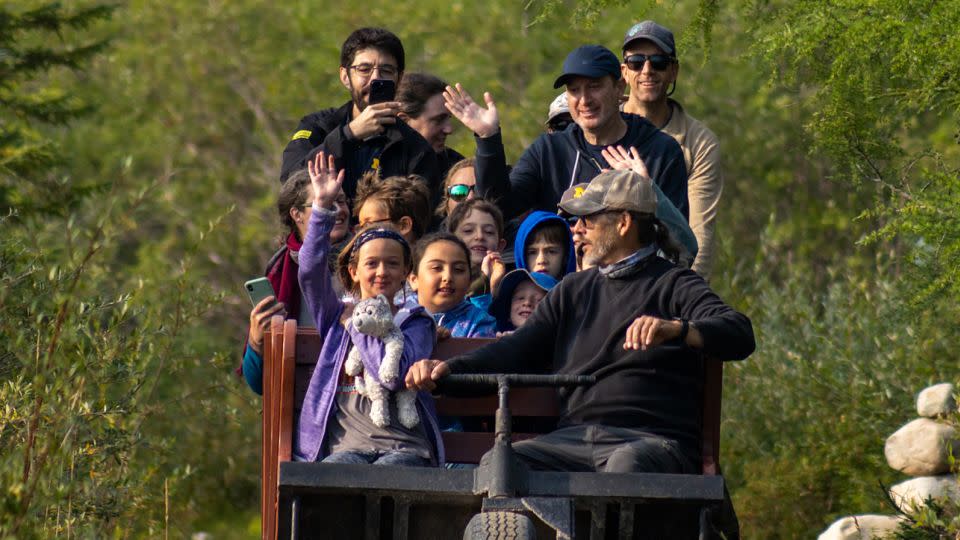
The parents got along as well as the kids, much to our collective relief, and were quickly comfortable admonishing whoever was playing polar bear guard with a condiment bottle at dinner or wreaking havoc in the back of the bus. One night, after they’d all gone to bed, we toasted with canned beers someone picked up from the grocery store in the Tundra Inn’s lobby and even caught a mild display of an early-season Aurora Borealis, peeking our heads outside the hotel door to look for both polar bears and the sky.
If you ask my son what his favorite moment from our trip was, he might say belugas to please me – but surely it was driving the Tundra Buggy. We had just seen a giant polar bear and skirted alongside tundra swans, sandhill cranes and a multitasking caribou (“Action shot!” shouted Baldwin, getting a giggle out of everyone since the animal was pooping while walking). But the moment the buggy driver passed Nico the wheel to what might as well be a monster truck on steroids and all his new friends started chanting his name as he steered us across the tundra, the biggest smile of the week lit up his face.
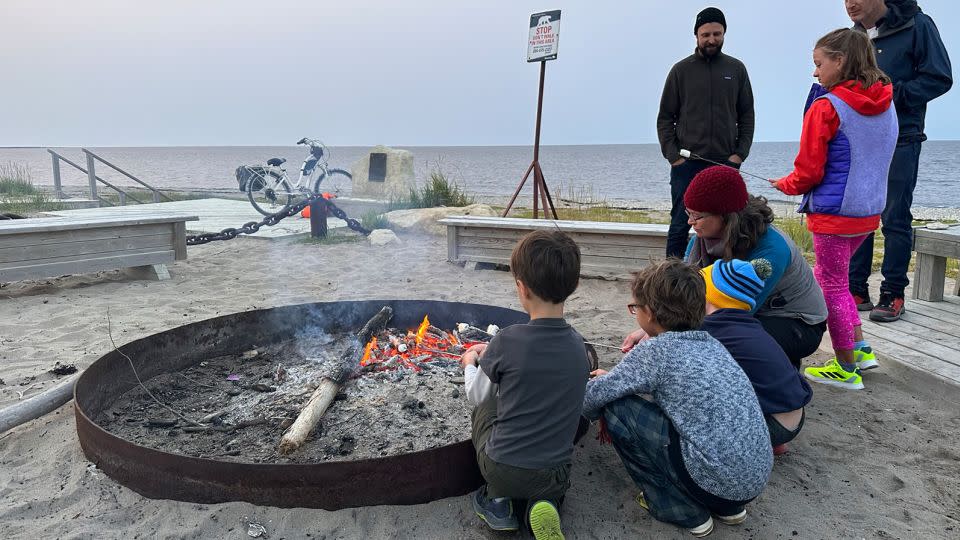
Later, my boy asked me if we’d ever see his new friends again.
On our last night in Churchill, we gathered at a bonfire on the beach for s’mores. Then we wandered down to the rocky shoreline to skip stones, the now familiar humps of belugas stretching to the horizon, the cold saline wash of Arctic Ocean in the air.
I looked at my son doing what he does on our retention pond back home—chucking rocks into the water while I worried he’d hit one of his friends. But this time it was with with a backdrop of belugas (safely out of rock range) for a change.
But I was done worrying if any of it was sinking in. We had been here together, and that was something.
As we walked back to the bus, I grabbed Nico by the hand, on high alert in polar bear territory.
“If you don’t see me panicking, mommy, there’s no reason to panic,” he said, gently letting go of my grip and following the other kids into the bus, using a line he’d clearly remembered from a safety protocol talk days before.
A seed had been planted, I was sure of it.
For more CNN news and newsletters create an account at CNN.com

